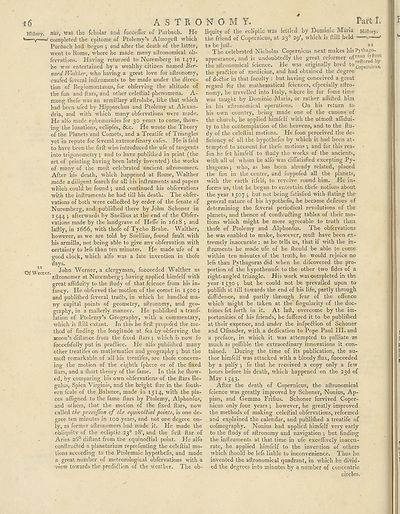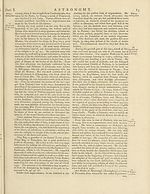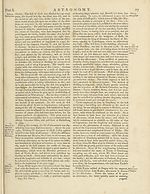Encyclopaedia Britannica, or, a Dictionary of arts, sciences, and miscellaneous literature : enlarged and improved. Illustrated with nearly six hundred engravings > Volume 3, ASS-BOO
(24) Page 16
Download files
Complete book:
Individual page:
Thumbnail gallery: Grid view | List view

i<5 ASTRO
Hiftory. waS Hie fcliolar and {‘ucceffor of Purbach. He
fe—completed the epitome of Ptolemy’s Almageft which
Purbach had begun j and after the death of the latter,
went to Piome, where he made many adronomical ob-
fervations. Having returned to Nuremberg in 1471,
he was entertained by a wealthy citizen named Ber¬
nard Wa/ther, who having a great love for aftronomy,
caufed feveral inflruments to be made under the direc¬
tion of Regiomontanus, for obferving the altitude of
the fun and ftars, and other celeftial phenomena. A-
ftiong thefe was an armillary aftrolabe, like that which
had been ufed by Hipparchus and Ptolemy at Alexan¬
dria, and with which many obfervations were made.
He alfo made ephemerides for 30 years to come, (bow¬
ing the lunations, eclipfes, &c. fie wrote the Theory
of the Planets and Comets, and a Treatife of Triangles
yet in repute for feveral extraordinary cafes. He is laid
to have been the firft who introduced the ufe of tangents
into trigonometry \ and to have publifhed in print (the
art of printing having been lately invented) the works
of many of the mod celebrated ancient aftronomers.
After his death, which happened at Rome, Walther
made a diligent fearch for all his inftruments and papers
which could be found ; and continued his obfervations
with the inftruments he had till his death. The obfer¬
vations of both were collefled by order of the fenate of
Nuremberg, and publiftied there by John Schoner in
1544 ; afterwards by Snellius at the end of the Obfer¬
vations made by the landgrave of Heffe in 1618 ; and
laftly, in 1666, with thofe of Tycho Brahe. Walther,
however, as we are told by Snellius, found fault with
his armilla, not being able to give any obfervation with
certainty to lefs than ten minutes. He made ufe of a
good clock, which alfo was a late invention in thofe
days.
Of Werner John Werner, a clergyman, fucceeded Walther as
aftronomer at Nuremberg ) having applied himfelf with
great affiduity to the ftudy of that fcience from his in¬
fancy. He obferved the motion of the comet in 1500 ;
and publiftied feveral trails, in which he handled ma¬
ny capital points of geometry, aftronomy, and geo¬
graphy, in a mafterly manner. Pie publiftied a tranf-
lation of Ptolemy’s Geography, with a commentary,
which is (till extant. In this he firft propofed the me¬
thod of finding the longitude at fea by obferving the
moon’s diftance from the fixed ftars ; which is now fo
fuccefsfully put in prailice. He alfo pubiiftied many
other treatifes on mathematics and geography ; but the
moft remarkable of all his treatifes, are thofe concern¬
ing the motion of the eighth fphcre or of the fixed
ftars, and a (liort theory of the fame. In this he (how-
ed, by comparing his own obfervations of the ftars Re-
gulus, Spica Virginis, and the bright ftar in the fouth-
ern fcale of the Balance, made in 1514, with the pla¬
ces afiigned to the fame ftars by Ptolemy, Alphonfus,
and others, that the motion of the fixed ftars, now
called the prece/Jion of the eqinno&ial points, is one de¬
gree ten minutes in 100 years, and not one degree on¬
ly, as former aftronomers had made it. He made the
obliquity of the ecliptic 230 28', and the firft: ftar of
Aries 26° diftant from the equino&ial point. He alfo
conftrudted a planetarium reprefenting the celeftial mo¬
tions according to the Ptolemaic hypothefis, and made
a great number of meteorological obfervations with a
view towards the prediflion of the weather. The ob-
N O M Y. Part I.
liquity of the ecliptic was lettled by B5ominic Tvlaria Hiftoryi
the friend of Copernicus, at 230 29', which is ftill held v- >
to be juft. _ 2 z
The celebrated Nicholas Copernicus next makes his Pythago-
appearance, and is undoubtedly the great reformer of^J-^y
the aftronomical fcience. He was originally bred to CoperniCUg,
the practice of medicine, and had obtained the degree
of dodtor in that faculty : but having conceived a great
regard for the mathematical fciences, efpecially aftro¬
nomy, he travelled into Italy, where he for fome time
was taught by Dominic Maria, or rather aftifted him
in his aftronomical operations. On his return to
his own country, being made one of the canons of
the church, he applied himfelf with the utmoft aflidui-
ty to the contemplation of the heavens, and to the ftu¬
dy of the celcftial motions. He foon perceived the de¬
ficiency of all the hypothefes by which it had been at¬
tempted to account for thefe motions •, and for this rea-
fon he fet himfelf to ftudy the works of the ancients,
with all of whom he alfo was diffatisfied excepting Py¬
thagoras j who, as has been already related, placed
the fun in the centre, and fuppofed all the planets,
with the earth ilfelf, to revolve round him. He in¬
forms us, that he began to enteitain thefe notions about
the year 1507 ; but not being fatisfied with dating the
general nature of his hypothefis, he became defirous of
determining the feveral periodical revolutions of the
planets, and thence of conftructing tables of their mo¬
tions which might be more agreeable to truth than
thofe of Ptolemy and Alphonfus. The obfervations
he was enabled to make, however, muft have been ex¬
tremely inaccurate : as he tells us, that if with the in¬
ftruments he made ufe of he ftiould be able to come
within ten minutes of the truth, he would rejoice no
lefs than Pythagoras did when he difcovered the pro¬
portion of the hypothenufe to the other two fides of a
right-angled triangle. His work was completed in the
year 1530-, but he could not be prevailed upon to
publifn it till towards the end of his life, partly through
diffidence, and partly through fear of the offence
which might be taken at the Angularity of the doc¬
trines fet forth in it. At laft, overcome by the im¬
portunities of his friends, he fuffered it to be publilhed
at their expence, and under the infpedlion of Schoner
and Oiiander, with a dedication to Pope Paul III. and
a preface, in which it was attempted to palliate as
much as poffible the extraordinary innovations it con¬
tained. During the time of its publication, the au¬
thor himfelf was attacked with a bloody flux, fucceeded
by a palfy ; fo that he received a copy only a few
hours before his death, which happened on the 23d of
Ma7 I543-
After the death of Copernicus, the aftronomical
fcience was greatly improved by Schoner, Nonius, Ap-
pian, and Gemma Frifius. Schoner furvived Coper¬
nicus only four years ; however, he greatly improved
the methods of making celeftial obfervations, reformed
and explained the calendar, and publiftied a treatife of
cofmography. Nonius bad applied himfelf very early
to the ftudy of aftronomy and navigation *, but finding
the inftruments at that time in ufe exceflively inaccu¬
rate, he applied himfelf to the invention of others
which (hould be lefs liable to inconvenience. Thus he
invented the aftronomical quadrant, in whicli he divid¬
ed the degrees into minutes by a number of concentric
circles.
Hiftory. waS Hie fcliolar and {‘ucceffor of Purbach. He
fe—completed the epitome of Ptolemy’s Almageft which
Purbach had begun j and after the death of the latter,
went to Piome, where he made many adronomical ob-
fervations. Having returned to Nuremberg in 1471,
he was entertained by a wealthy citizen named Ber¬
nard Wa/ther, who having a great love for aftronomy,
caufed feveral inflruments to be made under the direc¬
tion of Regiomontanus, for obferving the altitude of
the fun and ftars, and other celeftial phenomena. A-
ftiong thefe was an armillary aftrolabe, like that which
had been ufed by Hipparchus and Ptolemy at Alexan¬
dria, and with which many obfervations were made.
He alfo made ephemerides for 30 years to come, (bow¬
ing the lunations, eclipfes, &c. fie wrote the Theory
of the Planets and Comets, and a Treatife of Triangles
yet in repute for feveral extraordinary cafes. He is laid
to have been the firft who introduced the ufe of tangents
into trigonometry \ and to have publifhed in print (the
art of printing having been lately invented) the works
of many of the mod celebrated ancient aftronomers.
After his death, which happened at Rome, Walther
made a diligent fearch for all his inftruments and papers
which could be found ; and continued his obfervations
with the inftruments he had till his death. The obfer¬
vations of both were collefled by order of the fenate of
Nuremberg, and publiftied there by John Schoner in
1544 ; afterwards by Snellius at the end of the Obfer¬
vations made by the landgrave of Heffe in 1618 ; and
laftly, in 1666, with thofe of Tycho Brahe. Walther,
however, as we are told by Snellius, found fault with
his armilla, not being able to give any obfervation with
certainty to lefs than ten minutes. He made ufe of a
good clock, which alfo was a late invention in thofe
days.
Of Werner John Werner, a clergyman, fucceeded Walther as
aftronomer at Nuremberg ) having applied himfelf with
great affiduity to the ftudy of that fcience from his in¬
fancy. He obferved the motion of the comet in 1500 ;
and publiftied feveral trails, in which he handled ma¬
ny capital points of geometry, aftronomy, and geo¬
graphy, in a mafterly manner. Pie publiftied a tranf-
lation of Ptolemy’s Geography, with a commentary,
which is (till extant. In this he firft propofed the me¬
thod of finding the longitude at fea by obferving the
moon’s diftance from the fixed ftars ; which is now fo
fuccefsfully put in prailice. He alfo pubiiftied many
other treatifes on mathematics and geography ; but the
moft remarkable of all his treatifes, are thofe concern¬
ing the motion of the eighth fphcre or of the fixed
ftars, and a (liort theory of the fame. In this he (how-
ed, by comparing his own obfervations of the ftars Re-
gulus, Spica Virginis, and the bright ftar in the fouth-
ern fcale of the Balance, made in 1514, with the pla¬
ces afiigned to the fame ftars by Ptolemy, Alphonfus,
and others, that the motion of the fixed ftars, now
called the prece/Jion of the eqinno&ial points, is one de¬
gree ten minutes in 100 years, and not one degree on¬
ly, as former aftronomers had made it. He made the
obliquity of the ecliptic 230 28', and the firft: ftar of
Aries 26° diftant from the equino&ial point. He alfo
conftrudted a planetarium reprefenting the celeftial mo¬
tions according to the Ptolemaic hypothefis, and made
a great number of meteorological obfervations with a
view towards the prediflion of the weather. The ob-
N O M Y. Part I.
liquity of the ecliptic was lettled by B5ominic Tvlaria Hiftoryi
the friend of Copernicus, at 230 29', which is ftill held v- >
to be juft. _ 2 z
The celebrated Nicholas Copernicus next makes his Pythago-
appearance, and is undoubtedly the great reformer of^J-^y
the aftronomical fcience. He was originally bred to CoperniCUg,
the practice of medicine, and had obtained the degree
of dodtor in that faculty : but having conceived a great
regard for the mathematical fciences, efpecially aftro¬
nomy, he travelled into Italy, where he for fome time
was taught by Dominic Maria, or rather aftifted him
in his aftronomical operations. On his return to
his own country, being made one of the canons of
the church, he applied himfelf with the utmoft aflidui-
ty to the contemplation of the heavens, and to the ftu¬
dy of the celcftial motions. He foon perceived the de¬
ficiency of all the hypothefes by which it had been at¬
tempted to account for thefe motions •, and for this rea-
fon he fet himfelf to ftudy the works of the ancients,
with all of whom he alfo was diffatisfied excepting Py¬
thagoras j who, as has been already related, placed
the fun in the centre, and fuppofed all the planets,
with the earth ilfelf, to revolve round him. He in¬
forms us, that he began to enteitain thefe notions about
the year 1507 ; but not being fatisfied with dating the
general nature of his hypothefis, he became defirous of
determining the feveral periodical revolutions of the
planets, and thence of conftructing tables of their mo¬
tions which might be more agreeable to truth than
thofe of Ptolemy and Alphonfus. The obfervations
he was enabled to make, however, muft have been ex¬
tremely inaccurate : as he tells us, that if with the in¬
ftruments he made ufe of he ftiould be able to come
within ten minutes of the truth, he would rejoice no
lefs than Pythagoras did when he difcovered the pro¬
portion of the hypothenufe to the other two fides of a
right-angled triangle. His work was completed in the
year 1530-, but he could not be prevailed upon to
publifn it till towards the end of his life, partly through
diffidence, and partly through fear of the offence
which might be taken at the Angularity of the doc¬
trines fet forth in it. At laft, overcome by the im¬
portunities of his friends, he fuffered it to be publilhed
at their expence, and under the infpedlion of Schoner
and Oiiander, with a dedication to Pope Paul III. and
a preface, in which it was attempted to palliate as
much as poffible the extraordinary innovations it con¬
tained. During the time of its publication, the au¬
thor himfelf was attacked with a bloody flux, fucceeded
by a palfy ; fo that he received a copy only a few
hours before his death, which happened on the 23d of
Ma7 I543-
After the death of Copernicus, the aftronomical
fcience was greatly improved by Schoner, Nonius, Ap-
pian, and Gemma Frifius. Schoner furvived Coper¬
nicus only four years ; however, he greatly improved
the methods of making celeftial obfervations, reformed
and explained the calendar, and publiftied a treatife of
cofmography. Nonius bad applied himfelf very early
to the ftudy of aftronomy and navigation *, but finding
the inftruments at that time in ufe exceflively inaccu¬
rate, he applied himfelf to the invention of others
which (hould be lefs liable to inconvenience. Thus he
invented the aftronomical quadrant, in whicli he divid¬
ed the degrees into minutes by a number of concentric
circles.
Set display mode to:
![]() Universal Viewer |
Universal Viewer | ![]() Mirador |
Large image | Transcription
Mirador |
Large image | Transcription
Images and transcriptions on this page, including medium image downloads, may be used under the Creative Commons Attribution 4.0 International Licence unless otherwise stated. ![]()
| Permanent URL | https://digital.nls.uk/193166773 |
|---|
| Attribution and copyright: |
|
|---|
| Description | Ten editions of 'Encyclopaedia Britannica', issued from 1768-1903, in 231 volumes. Originally issued in 100 weekly parts (3 volumes) between 1768 and 1771 by publishers: Colin Macfarquhar and Andrew Bell (Edinburgh); editor: William Smellie: engraver: Andrew Bell. Expanded editions in the 19th century featured more volumes and contributions from leading experts in their fields. Managed and published in Edinburgh up to the 9th edition (25 volumes, from 1875-1889); the 10th edition (1902-1903) re-issued the 9th edition, with 11 supplementary volumes. |
|---|---|
| Additional NLS resources: |
|

